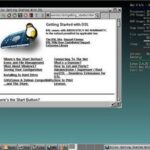I’m writing this article in a program called Tomboy. Tomboy is a very popular Linux program, but one I’d tried a while ago and not really liked. Or maybe I just didn’t have a use for it. Maybe I don’t now either, but I’m giving it another try, and am very much liking what I see.
For those who don’t know, Tomboy is an easy-to-use note taking application which also has some very simple Wiki features that make it a very powerful application for organizing your life.
To use Tomboy, start it up. You’ll see a yellow sticky-note icon appear in your Panel. Click this and you’ll see some options. You can create a new note, create a new notebook, search your notes, or view one of the two default notes, which describe how to use Tomboy. The first time you start it up, I’d recommend reading the note titled “Start Here” followed by “Using Links in Tomboy” as good introductions to the power of Tomboy.
Tomboy is really good for those times when you just need to jot down a piece of information, but don’t want to deal with starting up a full-fledged word processor, or having to choose what to name your document once you’ve written down what you want to remember. With Tomboy, you just create a new note and start typing! If you want, you can change the big blue, underlined text at the top, which will give your note a title that’s a bit more descriptive than “New Note 7” (or whatever your new note is called).
When you’re done, simply close the note. Tomboy automatically saves all your changes for you, so you don’t even need to worry about that.
Tomboy has some nice features for typing as well. You can simply use plain text, of course, but Tomboy also offers bold, italic, strikeout, highlight, fixed width, different sizes and the ability to make lists using bullets.
If you’ve looked at the screen shot provided, you’ll see me typing up this review inside Tomboy. If you can see (the screen shot should be big enough), you’ll notice some of those features, including highlighting, strikeout text and a few underlined, blue words. Those blue words are another of Tomboy’s really nice features.
If you have experience using Wiki software, especially on the Desktop, you’ll be familiar with something variously called WikiText or CamelText. Both those really describe the same thing. Both sets of words (WikiText and CamelText), you’ll notice, are two words, each capitalized, but smashed together with no spaces in between.
When you type words like that in Tomboy, they immediately become gray, with an underline. Clicking that word or words then creates a new note, titled the same. Using WikiText or CamelText is an easy way to create a new note, and have it instantly linked back to your original note. In fact, one of the cool things about Tomboy (not included, as far as I could tell, in another Wiki program I just reviewed, called Zim), is that in Tomboy, if you type a word that’s already the name of another note, Tomboy automatically creates a note. So it’s probably not a good idea to give one of your notes a name like “sports” especially if you talk about sports a lot, because if you do, each instance will turn blue and get an underline.
When you create notes, they sort of exist in their own space. If you look at the note browser (accessible via the “Search All Notes” option), you’ll see that you can look at all your notes, all the Unfiled Notes, or all the notes that exist in a certain Notebook. Keeping your notes filed together, especially ones that are a part of a project, is a great way to boost productivity.
In fact, some people have actually begun using Tomboy as their Getting Things Done (GTD) client, if you can believe it. And actually, as I look at Tomboy more and more, and see how it works, it makes sense. GTD tends to group your tasks into rigid folders, such as Today and Someday, and so Tomboy, with its Notebook feature, could easily be used in the same fashion.
Another nice feature Tomboy includes is the ability to be extended via its Add-In system. These Add-Ins can be anything from the ability to export your notes to HTML, to import sticky notes from other applications, to integrate with your Evolution Mail program (especially helpful, I’m told, for those using Tomboy as a GTD client), and adding printing support. If you use a program called Conduit, you can actually synchronize your Tomboy notes to other formats, and that feature, slightly modified, is included in Tomboy as well, even going so far as to offer the ability to load your notes to a web server.
I have to say I’m impressed. Tomboy offers a lot more now than it did when I last tried it (or else I just didn’t look hard enough last time), and the features it has are offered in a straight-forward, easy-to-use manner, which is great. Thanks to the plugins, I can add features I want, and ignore those I don’t. Tomboy looks nice, behaves really well, and does what I want. I’d tried a program a few days ago called Zim, and it kind of got me back looking at applications like this. Turns out I had the application I wanted all along, I just didn’t know it.
Tomboy is becoming more and more common, and seems to be included in almost all newer Linux distributions, at least the big ones (Ubuntu and Fedora in particular). It may already be installed on your Linux system, or is likely easily installed via your package manager. If not, it can be downloaded and installed via the Tomboy home page.






